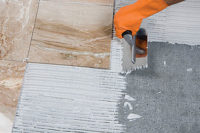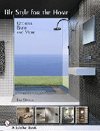Last month, the Natural Stone Institute and Stone World held a virtual Stone Summit, hosted by Arizona Tile. During the two-day session, entitled “Right Tools for the Right Job,” a number of points were discussed by a panel of industry experts. Among the questions that were top of mind included:
- What is the best blade for cutting marble, quartzite or other stones?
- Are pre-mixed color cartridge adhesives better than mixing by eye?
- What other tools should be considered?
The session, which covered the selection process for shop and installation tools and chemicals, was moderated by Mark Meriaux from the Natural Stone Institute and included Klint Olsen and Ed Mink, both of GranQuartz, on the first day, and Olsen joined by Adam Nelson of GranQuartz and Scott Higginbathom of Dry-Treat, on the second day.
Learning objectives outlined included:
- Review the different products available for cutting and finishing natural stone.
- Learn to compare cost, efficiency and safety as factors when evaluating tools and machinery.
- Learn what others consider “must-have” tools and equipment.
- Come away with a plan to standardize your tools and equipment and evaluate new and emerging tools as they become available.
Throughout the virtual session poll questions were taken to better understand the participants and their needs. The first question asked was: What do you use to cut slabs?
The audience’s response:
- Track Saw -- 19%
- Manual Bridge Saw -- 69%
- 5-Axis CNC Saw -- 44%
- Saw/Waterjet -- 50%
- Robotic Saw/Jet -- 25%
“The ‘unicorn’ that every fabricator wishes exists is that there is one blade that can cut everything,” said Meriaux.
Mink asked: “If you have one blade for everything, will you get the best cut?”
“What about the life?” asked Olsen. “If you are using one blade across all material, I would think it would be diminished.”
Mink told participants that if they are going to have only three blades in their shop, the most important are granite, porcelain and marble blades.
Another poll question asked: What material are you cutting mostly? The responses included:
- Granite – 86%
- Marble – 73%
- Quartzite – 36%
- Manufactured Quartz – 68%
- Porcelain/Sintered/Dekton – 27%
“I hear a lot about marble, and quartzite is growing, said Mink.
The discussion then moved to the importance of water when cutting. How does blade get out of tension? “Miter cuts are horrible on blades for tension,” said Meriaux. “It wreaks havoc on a blade when there is not enough water.”
When it comes to storing blades, Mink said that they should hang on a wall on a pegboard. “You don’t want to lay them flat,” he said. “They can get scratched if something is laid on top of them.”
It was then asked: “What do you do when a blade does get glazed and doesn’t cut well? “As long as it is a glazing issue, there are aluminum oxide dressing sticks,” said Mink. “If it is a heat and water issue, you can’t dress it. Even if you send it back to me, we probably can’t fix it.”
Another point brought up was table material and if it affects blade life. “I know a lot of fabricators that are going to a concrete table,” said Olsen.
“With a wood table, some guys don’t put in aluminum screws,” said Mink. “If you hit a steel screw, your blade is done.”
Adhesives and Sealers
On day two of the virtual Stone Summit, adhesives and sealers were the main topic. Learning objectives for the day were:
- Learn about different chemical adhesives and sealers used in fabrication and installation of natural stone.
- Learn the different characteristics of adhesives and how to select the right adhesive for the application.
- Learn about sealer chemistry and how to properly select and use the right sealer for the application.
- Come away with a better understanding of adhesives and sealers for optimum performance and profitability.
The panel took time to explain the different types of adhesives. They are as follows:
- Vinyl Ester Adhesives: A higher bond strength – a step above a polyester. “There are a lot of whites and light-colored stones,” said Nelson. “This glue is a white pearly light color. It can color match. It takes a level of skill to do that.”
- Epoxy Adhesives: Used to strengthen very weak stone that is very porous. “Your bond is very good, but you do have a drawback of time and possible yellowing,” explained Nelson.
- Modified Acrylics and MMA Cartridges: Highly convenient, an excellent bond strength and high technology. “They are going to come at a slightly higher cost, as you need a specialized dispensing gun for these,” said Nelson.
- Adhesives Suitable for Outdoor Use: The bond on these should not be compromised by heat or freeze-thaw. “Over time though, there will be some yellowing,” said Nelson. “It could be years.”
Higginbotham explained that .05% absorption can be called non-porous. “But that is not zero,” he said. “The stone can still stain.”
When it comes to water-based sealers there are great advantages such as low VOCs and they are easier for those without a lot of experience to use, according to Higginbotham. “Oil-based sealers have solvents that get a sealer deeper down than water,” he went on to say. “We use solvents like alcohol and turpentine, which can get down deeper and doesn’t change the color of the stone, but it is expensive and flammable.”
It was explained that there are different instructions to use for different types of sealers, and you need to know if it is mechanically or chemically bonded. “The best practice for working with chemicals is reading the instructions and following the instructions,” said Higginbotham.











